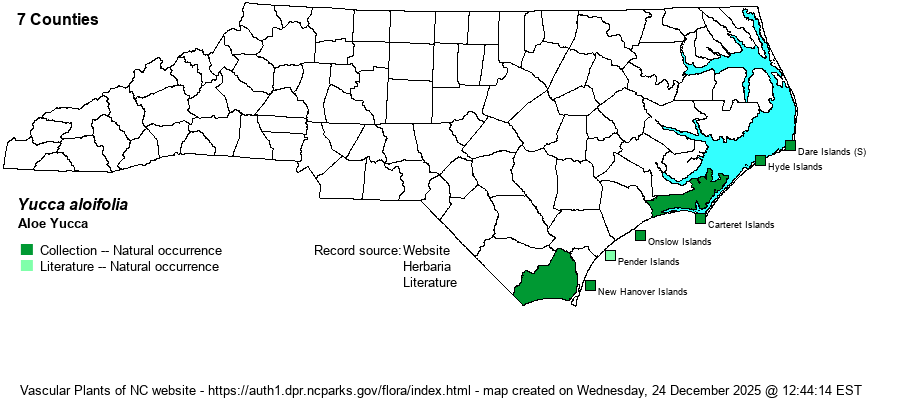| Author | L. | |
| Distribution | Strictly coastal, ranging from Dare County south to the SC state line. It is found in VA, so it ought to be found in Currituck County. Inland records - well away from maritime habitats - are persistent after planting or locally established and not mapped here.
Ranges from extreme southeastern VA south to southern FL and eastern TX. It does occur well inland in FL, AL, MS, LA, and TX, but is mainly coastal north of FL.
| |
| Abundance | Uncommon to locally numerous, but it can easily be confused with Y. gloriosa. Also, both species are frequently planted in coastal areas and yards, and thus separating natural locations from un-natural ones can be difficult. This is an NC Watch List species; though hardly a rare plant in NC, the restricted dune habitat has been impacted by coastal development, and there is uncertainty just how numerous native populations really are in the state. | |
| Habitat | Strictly on dunes and in sandy soil just behind dunes, always within a mile of the coast. |
| Phenology | Blooms in early to mid-summer, from June to July; fruits from October to December. | |
| Identification | This is one of two native species of yuccas with trunks, rarely reaching tree size (to 15 feet tall), but in NC it is most often seen as a basal rosette with a terminal flowering/fruiting stem. The evergreen leaves are stiff and rigid, typically about 2 feet long, narrowly elliptic with a very sharp tip. To identify this species from the quite similar Mound-lily Yucca (Y. gloriosa), run your finger lightly along the leaf margin. This species has green margins that are beset with numerous sharp but low teeth, and thus one could draw blood from rubbing the leaf margin too hard! (These teeth can be difficult to see more than a foot or two away.) Mound-lily Yucca has a very narrow brown leaf margin that is entirely smooth; again, this leaf margin is hard to see more than a foot away from the leaf. In addition, the leaves of Aloe Yucca are rather stiff and often tear or break when strongly bent in the middle; Mound-lily Yucca has more flexible leaves that often do not tear or break when bent. Also, this species blooms by mid-summer, in June and July; Mound-lily Yucca blooms much later, mostly in October. Both species have very attractive terminal clusters of large white, down-facing flowers. Note that Common Yucca (Y. filamentosa) can at times occur around dunes, but its leaves have filamentous/shreddy margins. | |
| Taxonomic Comments | None
| |
| Other Common Name(s) | Spanish Bayonet, Spanish Dagger | |
| State Rank | S2? [S3] | |
| Global Rank | G5 | |
| State Status | W1 | |
| US Status | | |
| USACE-agcp | UPL link |
| USACE-emp | FACU link |

